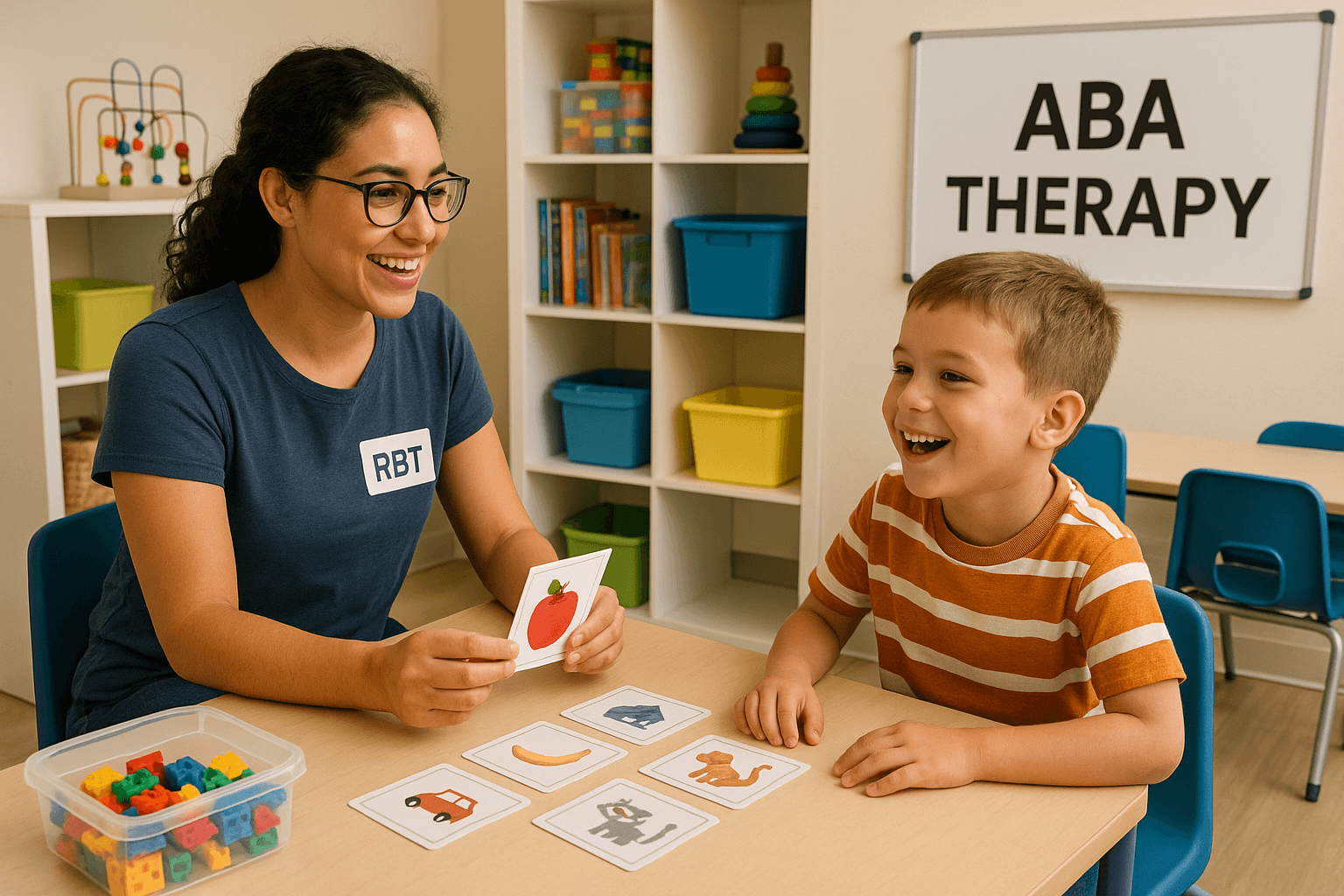Navigating ABA Early Intervention Programs: A Parent's Roadmap to Success
As a parent, your child's development ranks high among your priorities.
You aim to give them the best start in life, which is where ABA early intervention programs become vital.
Searching for top-quality early intervention services can evoke both anticipation and challenges.
For families seeking developmental support, especially for conditions like
autism spectrum disorder (ASD), Applied Behavior Analysis (ABA) early intervention shines as a beacon of hope.
Far from just a therapeutic method, ABA early intervention stands as a holistic strategy backed by empirical evidence.
Empowering children to surmount developmental challenges, ABA fosters growth in communication, social interactions, and adaptive behaviors.
However, navigating and maximizing the benefits of these programs can be daunting.
The Scope of ABA Early Intervention
ABA early intervention offers a vast scope with significant promise, especially for children with developmental issues like autism spectrum disorder (ASD).
For families in Riverside, San Bernardino, and Imperial Counties pursuing the best for their children, grasping the comprehensive scope of ABA early intervention is essential
.
Comprehensive Assessment: ABA early intervention begins with a thorough assessment of the child's current abilities and challenges.
This assessment serves as the foundation for creating individualized treatment plans tailored to the child's unique needs.
Targeted Skill Development: ABA programs focus on developing a wide array of skills, ranging from communication and language abilities to social interactions and adaptive behaviors.
These skills are essential for a child's overall development and improved quality of life.
Behavior Modification: A central aspect of ABA is behavior modification.
It involves identifying and addressing challenging behaviors while reinforcing positive ones.
Through precise analysis and interventions, ABA helps children replace undesirable behaviors with more adaptive alternatives.
Early Intervention: ABA recognizes the critical importance of early intervention.
Research consistently demonstrates that starting
ABA therapy at a young age can lead to more significant improvements in a child's development and long-term outcomes.
Data-Driven Approach: ABA relies on data collection and analysis to track progress accurately.
This data-driven approach ensures that interventions are continually adjusted to meet the child's changing needs and goals.
Family Involvement: ABA encourages family involvement and training.
Parents and caregivers are essential partners in the process, as they learn to implement ABA techniques in everyday situations, creating a supportive environment for the child's growth.
Generalization of Skills: ABA aims to ensure that skills learned during therapy sessions generalize to real-life situations.
This helps children apply what they've learned to various contexts, promoting independence and long-term success.
Transition Planning: ABA early intervention doesn't end when a child reaches a certain age.
Transition planning is an integral part of the process, ensuring that the child's progress is sustained as they move from early childhood into school-age years.
Collaboration: ABA therapists often collaborate with other professionals, such as speech therapists, occupational therapists, and educators, to provide a comprehensive and holistic approach to the child's development.
Understanding the expansive scope of ABA early intervention is the first step in harnessing its potential.
It's a multifaceted approach that empowers children and their families to overcome challenges, maximize their potential, and embrace a brighter future.
Accessing ABA Early Intervention
The journey to access ABA early intervention programs in Riverside, San Bernardino, and Imperial Counties starts by understanding the involved steps and available resources.
Here, we'll guide you through the process of accessing these crucial programs for your child.
Research and Information Gathering: Start by researching ABA early intervention providers in Riverside, San Bernardino, and Imperial Counties.
Seek recommendations from pediatricians, educators, and other parents who have experience with these programs.
Gather information about their credentials, experience, and the services they offer.
Initial Contact: Reach out to the ABA providers that pique your interest.
Contact them to express your interest and inquire about their availability.
Some providers may offer initial consultations or assessments to determine your child's specific needs.
Assessment and Evaluation: Many ABA programs require an initial assessment to evaluate your child's strengths, challenges, and developmental goals.
This assessment helps create an individualized treatment plan tailored to your child's unique needs.
Insurance Coverage: Check with your health insurance provider to understand your coverage for ABA therapy.
Many insurance plans now cover ABA services, but the extent of coverage may vary.
Ensure you understand the details of your policy and any out-of-pocket expenses.
Financial Assistance: Explore potential financial assistance options if your insurance coverage is limited. Some government programs or nonprofit organizations may provide financial support or grants to help cover the costs of ABA early intervention.
Choosing the Right Provider: Select an ABA provider that aligns with your child's needs and your family's values.
Consider factors like the provider's experience, approach, location, and availability of services that match your child's age and requirements.
Individualized Treatment Plan: Once your child begins ABA therapy, collaborate closely with the ABA team to develop and review the individualized treatment plan.
This plan outlines specific goals and objectives tailored to your child's development.
Progress Monitoring: ABA therapy involves continuous monitoring and data collection to track your child's progress.
Regular meetings with the ABA team will allow you to stay informed about your child's development and make any necessary adjustments to the treatment plan.
Family Training: Many ABA programs involve family training to equip parents and caregivers with the knowledge and skills to support their child's progress outside of therapy sessions.
Active family involvement is often integral to success.
Advocacy and Support: Connect with local support groups and advocacy organizations in Riverside or Imperial County.
These groups can provide valuable guidance, resources, and emotional support as you navigate the ABA early intervention journey.
Accessing ABA early intervention programs is a significant step toward providing your child with the support they need for positive development.
By following these steps and staying engaged in the process, you can help your child thrive and reach their full potential.
The ABCs of ABA
Diving into the basics:
What is ABA therapy, and how does it work?
Applied Behavior Analysis (ABA) is a robust method for understanding and altering behavior. It breaks down behavior into three key components:
A - Antecedent: This is what happens right before a behavior occurs. It's the trigger or the event that sets the stage for a behavior.
B - Behavior: This is the specific action or response to the antecedent. It's what we observe and want to either encourage or change.
C - Consequence: This is what happens immediately after the behavior. It can either reinforce or discourage the behavior.
ABA uses these ABCs to analyze behavior patterns, identify potential causes, and develop strategies to promote positive behavior change. It's a valuable tool for individuals with autism and many other areas of behavior management.
The Role of ABA Therapists
ABA therapists play a pivotal role in guiding individuals with autism and other developmental challenges towards their maximum potential.
Their dedication, expertise, and compassionate approach contribute significantly to enhancing the quality of life for those they serve.
Here's an overview of the key roles and responsibilities of ABA therapists:
Assessment and Evaluation:
To conduct initial assessments to understand the individual's strengths, weaknesses, and specific behavioral challenges.
To continuously evaluate progress and adjust treatment plans as needed.
Individualized Treatment Plans:
To develop personalized treatment plans tailored to the unique needs and goals of each individual.
To set clear and measurable objectives to track progress effectively.
Direct Intervention:
Implementing ABA techniques and interventions to target and modify specific behaviors.
Providing direct one-on-one therapy sessions, group sessions, or classroom support, depending on the individual's needs.
Data Collection and Analysis:
Systematically collecting data on target behaviors to assess progress and adjust interventions accordingly.
Analyzing data to identify patterns, trends, and areas for improvement.
Behavioral Strategies:
Employing evidence-based behavioral strategies to reinforce desired behaviors and reduce problematic ones.
Using positive reinforcement, prompting, shaping, and other techniques to encourage skill development.
Communication and Collaboration:
Maintaining open and effective communication with parents, caregivers, and other professionals involved in the individual's care.
Collaborating with other therapists, educators, and healthcare providers to ensure a holistic approach to treatment.
Skill Development:
Focusing on teaching a wide range of skills, including communication, social, adaptive, and academic skills.
Fostering independence and enhancing the individual's ability to function effectively in their daily life.
Behavioral Support Plans:
Developing and implementing behavior support plans to address challenging behaviors in a proactive and positive manner.
Promoting alternatives to problem behaviors and ensuring the safety and well-being of the individual.
Crisis Management:
To possess the skills and knowledge to manage challenging behaviors or crisis situations safely and effectively.
Implementing crisis intervention techniques when necessary.
Advocacy and Education:
Educating parents and caregivers about ABA principles and techniques, empowering them to support the individual's progress.
Advocating for the rights and needs of individuals with autism or developmental disorders within the community.
Professional Development:
Staying current with the latest research and developments in the field of ABA through ongoing training and education.
Seeking certification and licensure as appropriate to maintain professionalism and competence.
ABA Early Intervention: Advantages and Limitations for Children with ASD
Every program, including ABA, has its strengths and drawbacks.
Pros of ABA Early Intervention:
Proven Effectiveness:
Multiple studies underscore ABA's impact on enhancing communication, social interactions, and adaptive behaviors in children.
Individualized Treatment: ABA programs are tailored to the specific needs and abilities of each child.
This individualization allows for personalized treatment plans that address the unique challenges of each child with ASD.
Early Intervention: ABA can begin as early as diagnosis, often during toddler years.
Early intervention can lead to more significant improvements in behavior and skills, as the brain is more adaptable during early childhood.
Skill Development: ABA focuses on skill development across various domains, including language, communication, self-help, and social skills.
It helps children acquire crucial skills that improve their quality of life.
Behavior Management: ABA techniques are effective in reducing challenging behaviors, such as aggression, self-injury, or tantrums, which can be common in children with ASD.
It promotes the replacement of problem behaviors with more adaptive ones.
Generalization: ABA aims to ensure that newly acquired skills generalize to different settings and people, increasing a child's independence and ability to function effectively in various environments.
Cons of ABA Early Intervention:
Time-Intensive:
ABA therapy frequently demands a substantial time investment, often spanning several sessions a week.
This can be challenging for parents and caregivers to manage alongside other responsibilities.
Cost: ABA therapy can be expensive, especially if insurance coverage is limited or unavailable.
This financial burden can create disparities in access to early intervention services.
Controversial History: ABA has a controversial history, with some past practices considered overly strict or harmful.
However, contemporary ABA emphasizes positive reinforcement and ethical treatment.
Intensive Data Collection: Data collection is a fundamental aspect of ABA, but it can be time-consuming.
Therapists must record data on behaviors and interventions during each session.
Parent Involvement: Effective ABA often requires active involvement from parents or caregivers, as they play a crucial role in reinforcing skills learned during therapy sessions.
It's important to note that the pros and cons of ABA early intervention can vary depending on the specific program, the therapist's approach, and the child's unique needs.
Parents and caregivers should work closely with professionals to determine the most appropriate intervention plan for their child with autism.
Initiating ABA Early Intervention: A Step-by-Step Guide
Eager to embark on the ABA journey?
Our comprehensive guide will navigate you through the initiation process of ABA early intervention, specifically tailored for residents in Riverside, San Bernardino, and Imperial Counties.
From finding the right providers to understanding the resources available, we've got you covered.
You can start today by
visiting our website.
Conclusion
In summation, ABA early intervention offers a beacon of hope for children grappling with developmental challenges.
Recognizing the significance of early intervention, leveraging appropriate resources, and acknowledging ABA's distinct advantages will set the stage for your child's brighter future.
FAQs
What are ABA early intervention programs, and how do they work?
ABA early intervention programs are evidence-based therapies designed to help children with developmental challenges, including autism spectrum disorder (ASD). These programs use the principles of Applied Behavior Analysis to assess behavior, develop individualized treatment plans, and teach valuable skills to children. ABA therapists work closely with children to promote positive behaviors and reduce challenging ones.
What conditions and challenges can ABA early intervention programs address?
ABA early intervention programs are particularly effective in addressing developmental conditions like autism spectrum disorder (ASD). They can help improve communication skills, social interactions, and adaptive behaviors in children with ASD. Additionally, ABA can benefit children with other developmental challenges, learning disabilities, and behavioral issues.
How can parents or caregivers access ABA early intervention programs for their children?
Accessing ABA early intervention programs in Riverside, San Bernardino, and Imperial Counties involves several steps. Parents or caregivers should start by researching local ABA providers, assessing their credentials, and reviewing program options. Once you've selected a provider, contact them to discuss your child's needs and initiate an evaluation process. Many ABA programs require assessments to develop individualized treatment plans.
What are the key principles and techniques used in ABA early intervention?
ABA early intervention programs are grounded in several key principles, including positive reinforcement, data-driven decision-making, and individualized treatment plans. Techniques commonly used include discrete trial training, naturalistic teaching strategies, and structured interventions to address specific goals. These methods are designed to teach new skills, shape behavior, and promote independence.
Are there any success stories or testimonials from families who have benefited from ABA early intervention?
Absolutely! Riverside, San Bernardino, and Imperial Counties have witnessed numerous success stories of children who have thrived thanks to ABA early intervention. These stories highlight significant improvements in communication, social interactions, and overall quality of life. Stay tuned in this article for some inspiring real-life success stories.
What role does a qualified ABA therapist play in these programs?
Qualified ABA therapists are essential to the success of ABA early intervention programs. They conduct assessments, design individualized treatment plans, implement interventions, and continuously evaluate progress. ABA therapists work closely with children, using positive reinforcement and evidence-based techniques to promote desired behaviors and skills.
How does ABA early intervention compare to other early intervention methods?
While ABA is a widely recognized and evidence-based approach, it's essential to consider how it compares to other early intervention methods.
What are the potential benefits and limitations of ABA early intervention?
ABA early intervention offers numerous benefits, such as improved communication, social skills, and behavior management. However, it's important to acknowledge potential limitations, such as the intensity of therapy and costs involved.
Are there any financial considerations or insurance options for ABA early intervention?
Finances can be a concern for families seeking ABA early intervention. Many insurance providers offer coverage for ABA therapy, although specific policies vary.
How can families get started with ABA early intervention, and what resources are available to support them?
Getting started with ABA early intervention involves several steps, from researching providers to initiating assessments. We'll provide a comprehensive guide to help families in Riverside, San Bernardino, and Imperial Counties embark on their journey with ABA early intervention.











